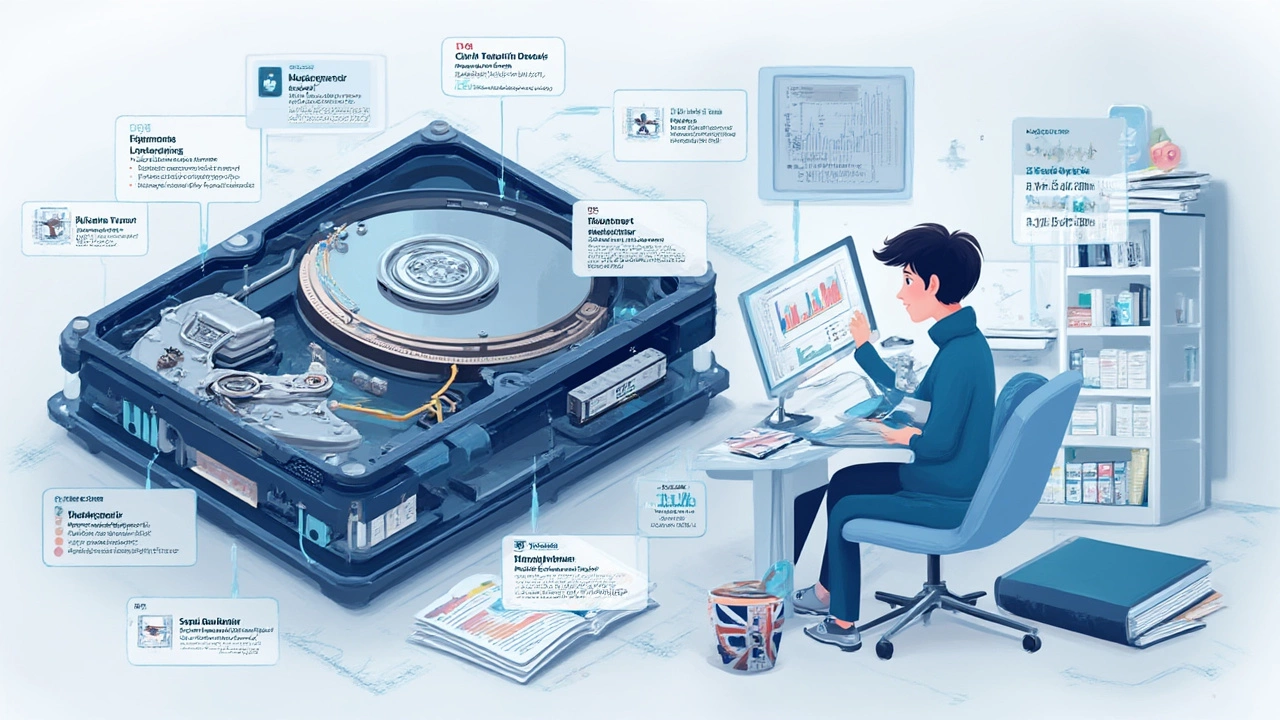Your computer boots in ten seconds at work, but your old laptop at home takes a leisurely minute and a half for coffee and reflection. You might blame software bloat or operating system updates, but the real culprit often lurks under the hood: the hard drive. Hard drives are the grumpy librarians of your digital life. Some grab a file in a flash; others need to dust off encyclopedias and shuffle around. If you’ve ever asked yourself why, you’re in the right place. Hard drive speed isn’t magic—it’s engineering. The difference between a fast and slow drive can be the difference between a quick gaming session and waiting ages for a file to move. Forget the jargon and marketing fluff. We're getting hands-on and practical. Let's sort out what really makes a hard drive fast—and how you can use that knowledge next time you stare at the specs in an electronics store or try to fix a sluggish computer.
How Hard Drive Speed Is Measured—and Why It Matters
Hard drive speed is not just a single number or a snazzy logo on the box. It’s about a chain of characteristics that dictate how quickly your computer can load, save, and find files. The go-to number everyone talks about is transfer rate—measured in MB/s (megabytes per second) or GB/s (gigabytes per second). Imagine it as the width of the onramp onto a busy highway for your data. But it’s not just raw speed; it’s also about access time, the small delay before a file starts moving. That delay can feel longer than it really is, especially if you’re used to instant app launches on your phone, while your laptop hesitates.
There are two major types of hard drives: the classic spinning hard disk drive (HDD) and the newer solid-state drive (SSD). HDDs use spinning disks and a mechanical arm, much like a record player. SSDs use flash memory chips, which have no moving parts—so data gets found and delivered blazingly quick. A typical HDD used in laptops or desktops spins at 5400 or 7200 rotations per minute (RPM). More RPM means less waiting, but also more heat and maybe more noise. SSDs, though, ditch that old-school machinery—no spin, no delay, just electric pulses zipping data to and from chips.
Don’t buy the myth that “bigger is faster.” A one-terabyte drive can be slow as syrup if it’s built for cheapness, not speed. Instead, the secret sauce includes:
- Data Transfer Rate: How fast big chunks of files move between drive and the rest of the computer.
- Latency: The lag between your click and when the drive actually starts reading or writing the info.
- Interface: The connection type to your computer—think SATA III, PCIe, NVMe, or good old USB. Faster interfaces, like NVMe, let even fast SSDs stretch their legs.
- Cache: A buffer of memory that speeds up frequent or recent file requests.
- Firmware: The instructions the drive follows can make or break its performance over time.
Solid-state drives get top marks because they skip the mechanical arm and spinning platter, leading to dramatically lower latency. For example, a high-end NVMe SSD can hit more than 3500 MB/s, while the best old-school HDDs might reach 150 MB/s on a good day. That’s not a typo. If you ever reload your operating system, moving from an HDD to SSD is night-and-day difference—suddenly your computer boots in seconds, apps open up like a spring-loaded trap, and file transfers don’t bring your whole afternoon to a crawl.

What Affects Hard Drive Speed—And How You Can Use This Info
If you want to get nerdy, here’s the breakdown: Each part of the hard drive setup can either speed you up or drag you down. The physical hardware is the foundation, but it’s just one part of the story.
- Spindle Speed (HDDs Only): For a hard disk, the RPM is basic—7200 RPMs is generally twice as fast as 5400, though noise and heat usually track right alongside that speed boost. The difference is noticeable if you do any kind of big file movement or run lots of applications at once.
- Flash Quality (SSDs): Not all SSDs are equal. Cheaper ones use TLC (triple-level cell) or QLC (quad-level cell) flash chips, which cram more data into each cell but can get worn out or slow down write speeds over time. The fancier SLC (single-level cell) chips are faster, more durable, and a heap more expensive. But unless you’re running video edits all day, most mainstream SSDs are plenty quick for regular life.
- Connection Port: SATA III is the standard for most hard drives, maxing out at around 600 MB/s. But the moment you snap an SSD into a PCIe/NVMe slot, you unlock about five to six times that speed potential. The catch: your computer’s motherboard needs to support these ports. Older laptops just won’t have the slots for NVMe drives, and not every desktop has the right connectors either. No point in buying an ultra-fast SSD if it’ll be handcuffed by your hardware’s slow lane.
- File System and Fragmentation: File systems aren’t something you usually worry about, but choosing between NTFS, exFAT, or APFS can affect efficiency, especially for massive files. Old-school fragmentation—a major pain in the bum for HDDs—can slow down reads by scattering file parts all over. SSDs, thanks to no moving parts, aren’t really bothered, but regular maintenance and trimming (sort of a digital housecleaning) help them stay spry.
- Cache Size: Drives include small but speedy RAM chips to keep frequently used data at the ready. More cache, within reason, smooths out hiccups when copying lots of tiny files or working with huge apps.
- Temperature Management: Drives get hot, especially high-performance SSDs packed into tight laptops. Overheating slows most drives down—sometimes dramatically—so a good cooling setup or at least not choking vents with dust helps more than you’d expect.
- Real-World Usage: Different workloads need different speed. If you just browse the web, even an average SSD blows older HDDs away. If you edit video, play the latest games, or run virtual machines, that’s where high-end SSDs (with fast random read/write) shine brightest.
People often focus too much on benchmarks—synthetic speed tests that may not match your day-to-day experience. Sure, that bar graph looks impressive, but consider what you actually need. If you want near-instant startup times, fast app launches, or quick file copies, *hard drive speed* is your best friend. But if you mostly store photos and rarely move them around, spend your money on storage space instead.
For laptop upgrades, nothing feels more rejuvenating than swapping the old HDD for an SSD. It’s like trading in hiking boots for running shoes. In New Zealand, SSD prices have dropped steadily year after year, and even budget models make a world of difference. Plus, you get peace and quiet—no more spinning sounds or worrying about bumping your laptop and killing a platter.

Tips for Getting the Fastest Results From Your Hard Drive
Here’s where the rubber meets the road: how to squeeze the most zip from your current drive, or make a smart upgrade. Some things are easy DIY wins, while others are more about making the right buying choices upfront.
- Upgrade to SSD: If you’re still on any kind of spinning drive—no matter the size—jumping to an SSD is the most dramatic upgrade for everyday computing. Even plug-in USB SSDs blow external HDDs out of the water. For desktop PCs, make sure your motherboard offers a PCIe/NVMe slot if you want the absolute fastest SSD speeds around.
- Check Your Firmware: Drives can get sluggish from outdated firmware (like a recipe gone wrong). Updating your SSD’s toolbox—straight from the manufacturer—can solve quirks, bugs, or weird slowdowns. It’s simpler than you think and often just a download and a couple of clicks.
- Mind Your Free Space: Drives, especially SSDs, need breathing room. If your drive is over 80% full, performance starts to drop noticeably. Try to keep at least 20% free if possible. Move big files to cloud or external storage if you’re tight on space.
- Tidy Up Regularly: For HDDs, run defragmenter tools a few times a year—your files get reorganized for quicker access. For SSDs, run the TRIM command or use the drive’s management utility. This tells the drive which data is safe to clear and keeps writes fast.
- Don’t Cheap Out on the Interface: Using a speedy SSD over a slow USB 2.0 port is like trying to squeeze a truck through a letterbox. Check your ports before buying—and match the drive to the port. For laptops, sometimes it’s worth looking at a USB-C or Thunderbolt external SSD for serious speed.
- Watch for Slow-Downs: If your drive starts coughing and spluttering (long boot times, files taking ages to load), check drive health using tools like CrystalDiskInfo or the Mac Disk Utility. Drives sometimes fail gradually, not instantly—back up what you care about and don’t put off replacing a dying drive.
- Custom PCs and Laptops: If you’re building your own rig, spend a bit extra on a high-quality SSD for the boot drive (where your operating system lives). For bulk storage, big HDDs are still good value—use them for infrequently accessed files like backups or movie archives.
- Take Advantage of Caching: Windows, macOS, and Linux bring their own tricks here. Make sure you’ve got enough RAM, and let the OS cache commonly used apps or documents. This makes old drives seem faster, at least for repeat operations.
Hard drive speed isn’t some distant tech obsession—it’s the difference between waiting around or getting stuff done. Whether you’re working from a chilly Wellington home office, gaming late into the night, or editing drone photos from Mākara Beach, the right combination of drive type, connection, and know-how changes everything. Next time someone wonders why their computer drags, you’ll know the secret handshake—and maybe give them the nudge to finally upgrade.

